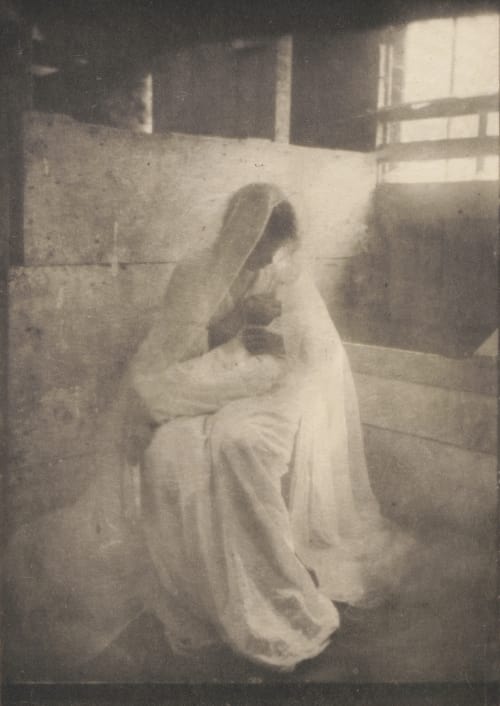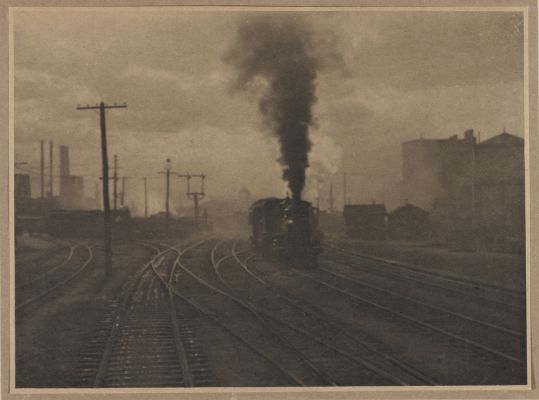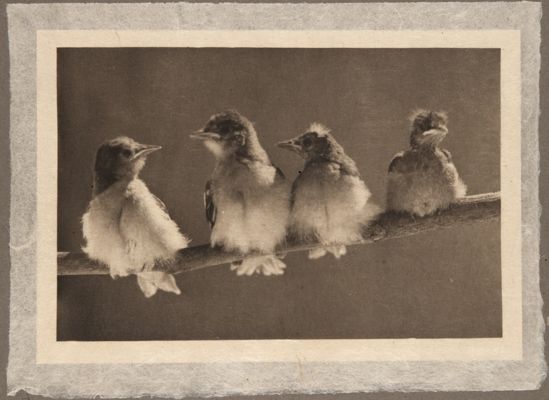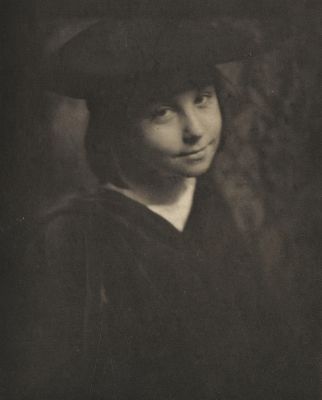
Title
The MangerArtist
Kasebier, Gertrude (American, 1852-1934)Publication
Camera Work IDate
1903Process
PhotogravureAtelier
Photochrome Engraving Company, New YorkImage Size
21.3 x 15 cm
From its debut at the Philadelphia Salon exhibition in 1899, The Manger became one of Käsebier’s best known and highly regarded photographs. Made in the summer of that year in the stable at Long Meadow, her Newport, Rhode-Island, cottage, The Manger is among the most accomplished of Käsebier’s many depictions of motherhood. The model for the photograph is Käsebier’s friend, the illustrator Frances Delehanty. She is clothed in layers of delicate translucent fabric that may have belonged to photographer F. Holland Day, a visitor to Long Meadow that summer, who had come equipped with a trunk of costume clothing. The Manger was heralded at the 1899 Philadelphia Salon, and Alfred Stieglitz stated that it was generally considered the gem of the exhibition. In the fall of that year, Käsebier sold a print of the image to the English actress, Ellen Terry, for one hundred dollars, an astonishing sum at a time when photography’s status as a fine art was far from assured. Stieglitz himself thought highly enough of the picture to include it in Camera Notes, and again in the very first issue of Camera Work, where it is illustrated in photogravure as the second plate. Two appreciations of Käsebier’s work also appear in this issue: one by fellow photographer, Frances Benjamin Johnson, and the other by critic Charles H. Caffin. Caffin singled out The Manger for praise, lauding its depiction of figures of touching refinement in rude surroundings, irradiated with a soft flood of light that fills the place with heaven and surrounds the figures with divinity. [2] Stieglitz also included The Manger in his American Pictorial Photography, Series II, portfolio, along with Blessed Art Thou Among Women. The Manger was widely exhibited in the first decade of the 20th century. Most notably, it was included in the selection of twenty-two Käsebier photographs shown at the landmark International Exhibition of Pictorial Photography at the Albright Art Gallery in Buffalo in 1910. This exhibition, organized by Stieglitz, was regarded at the time as the definitive statement on the art of photography as it was currently practiced. Once again, The Manger was singled out for special attention when the Albright purchased Käsebier’s print of the image after the exhibition closed. [3]
Reproduced / Exhibited
Galassi, Peter, American Photography, 1890-1965, from The Museum of Modern Art (The Museum of Modern Art, 1995, in conjunction with the exhibition), p. 84
Homer, William Innes, A Pictorial Heritage: The Photographs of Gertrude Käsebier (University of Delaware and the Delaware Art Museum, 1979, in conjunction with the exhibition), pl. 19
Homer, William Innes, and Johnson, Catherine, Stieglitz and the Photo-Secession 1902 (New York, 2002), unpaginated
Margolis, Marianne Fulton, Camera Work: A Pictorial Guide (New York, 1978), p. 1
Michaels, Barbara L., Gertrude Käsebier: The Photographer and Her Photographs (New York, 1992), p. 53
Peterson, Christian A., Alfred Stieglitz’s Camera Notes (Minneapolis Institute of Arts, 1993, in conjunction with the exhibition), pl. 52
Stieglitz, Alfred, Richard Whelan, and Sarah Greenough. Stieglitz on Photography: His Selected Essays and Notes. New York, NY: Aperture Foundation, 2000. p. 163
Frank, Waldo D. America and Alfred Stieglitz: A Collective Portrait. New York: Aperture, 1979. pl. 27
References
[1] Barbara Michaels, Gertrude Kasebier: The Photographer and her Photographs, p. 61
[2] Camera Work I, p. 16
[3] Sothebys Photographs 15 October 2007 • New York cited 02/22/23 www.sothebys.com/en/auctions/ecatalogue/2007/photographs-n08349/lot.133.html






